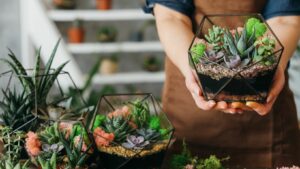There’s a unique satisfaction that comes from breathing life into your own garden through DIY projects. Whether you’re a seasoned green thumb or a novice gardener, there’s always a project that can transform your green space into a personal paradise.
DIY garden projects not only enhance the aesthetic appeal of your space, but they also provide an opportunity to engage with nature in a hands-on, creative way. From creating your own planters to designing a beautiful bird bath, we’ll delve into projects that can be both fun and rewarding.
Garden DIY Projects
 In the garden DIY world, more perks arise than just creating a visually appealing green space. These projects come bundled with numerous advantages that go beyond the obvious.
In the garden DIY world, more perks arise than just creating a visually appealing green space. These projects come bundled with numerous advantages that go beyond the obvious.
When I undertake garden DIY projects, saving money always jumps out as an immediate benefit. Store-bought garden decorations and structures often carry hefty price tags. However, DIY projects offer a cost-effective solution. For example, instead of purchasing a dainty bird feeder, which could cost upwards in the double digits, I can use everyday materials like old teacups or wooden planks. It’s practical and brings down the expenditure.
Customization and Creativity
Another perk worth mentioning is the immense scope for customization that garden DIY projects offer. I’m not constrained by the available designs in the market. Instead, I can let my creativity fly. If I fancy a whimsical fairy garden, I can craft one by painting pebbles, or if a contemporary bamboo water feature piques my interest, I can build it by just following a DIY tutorial.
Popular Garden DIY Projects for Beginners
 Gazing at the myriad of garden projects awaiting your attention, the DIY route offers countless opportunities. This segment unveils tried-and-true beginner-friendly endeavors, perfect for your creative exploration.
Gazing at the myriad of garden projects awaiting your attention, the DIY route offers countless opportunities. This segment unveils tried-and-true beginner-friendly endeavors, perfect for your creative exploration.
Elevating your plants is more than a style statement. It’s a strategic move, great for beginners. Raised garden beds guarantee that everything you wish to grow is within sight and reach. They also enhance soil drainage, thus countering over-watering issues.
Constructed in a broad array of materials, from lumber to concrete blocks, these beds come in an assortment of shapes and sizes. Here’s a simple layout: start with selecting a sunny spot, preferably with a flat terrain. Next, frame the bed dimensions, pile up soil within this frame and ultimately, seed it with your favorite plants.
Creating a Compost Bin
Reverting to Mother Nature’s waste management is a DIY project with ecosystem benefits. Compost bins convert kitchen scraps and yard waste into soil-enriching compost. Plastic tubs, wood pallets, or wire cages make good vessels for this purpose.
To create a functional compost bin, stick with these steps: first, pick a dry, shady spot near an accessible water source. Second, dig a hole and lay twigs or straw first then add layers of organic material, alternating between brown (branches, twigs) and green (fruit and vegetable waste). Top with a layer of soil.
Advanced DIY Projects for Seasoned Gardeners
 Evolving the skill set from beginner to advanced DIY projects amplifies my bond with gardening, initiating innovative ways to boost beauty and utility in my personal green space. Let’s delve into two tropical projects: installing a garden pond and setting up a drip irrigation system.
Evolving the skill set from beginner to advanced DIY projects amplifies my bond with gardening, initiating innovative ways to boost beauty and utility in my personal green space. Let’s delve into two tropical projects: installing a garden pond and setting up a drip irrigation system.
Venturing into more advanced techniques, the installation of my own garden pond emerges as a thrilling experience. It acts as the centerpiece, adding an idyllic charm to the garden. From selecting the perfect spot, considering the local climate, to excavating the ground, the process requires attentive consideration at every step. I deploy a plastic liner to retain water, making sure to contour the bottom and margins to simulate a natural pond.
Setting Up a Drip Irrigation System
Efficiency in water use continues to be a pressing matter in gardening. One way I tackle this is by setting up a drip irrigation system. Not only does it reduce water consumption, but it also regulates water distribution, ensuring that the roots of all my plants receive an optimal and steady supply of water.



